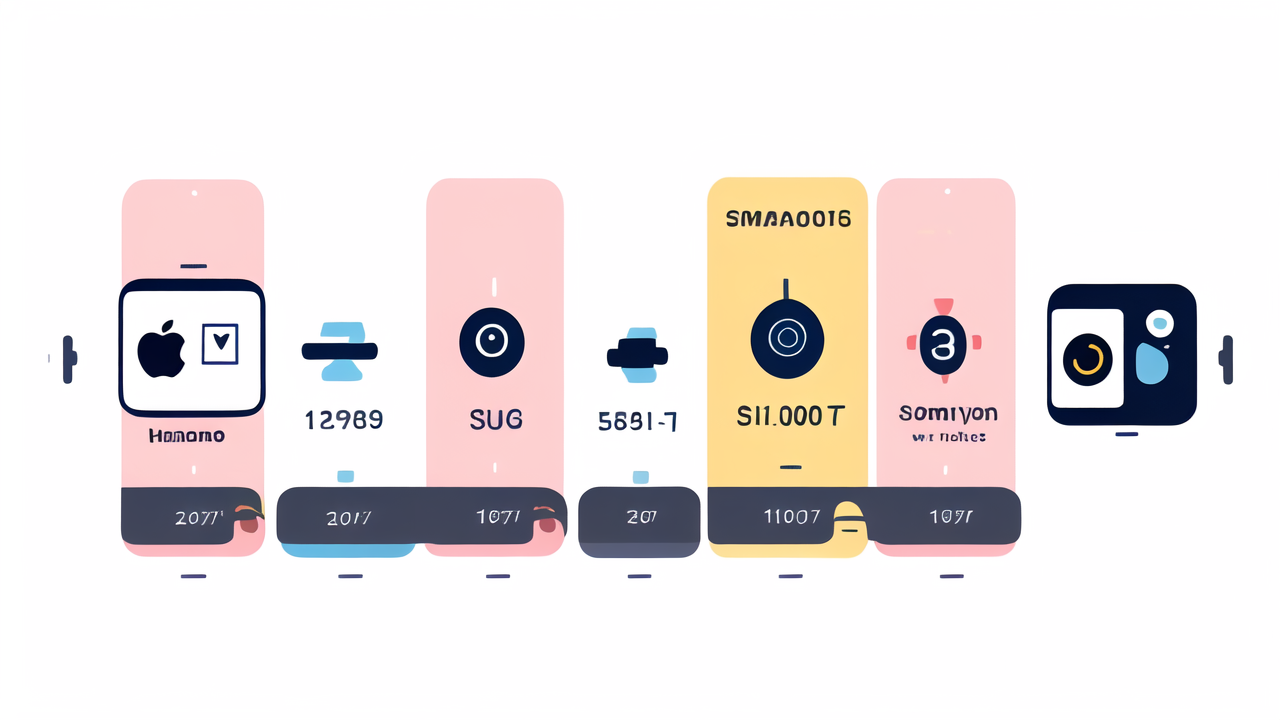Understanding the Evolution of Smart Watches
The Birth of Smart Watches: A Historical Perspective
Smart watches have come a long way since their inception. The first digital watch, the Pulsar, debuted in 1972. It was a far cry from today's smart watches. These early devices could only tell time and perform basic calculations.

As technology advanced, so did watches. The 1980s saw the rise of calculator watches. These were popular among students and professionals. In the 1990s, watches began to store data and connect to computers.
The true smart watch era began in the early 2000s. Companies like Microsoft and Sony released watches with advanced features. These included email notifications and music playback. However, they were bulky and had limited battery life.
Major Milestones in Smart Watch Development
Several key milestones shaped the smart watch industry. In 2012, Pebble launched its first smart watch via Kickstarter. It was a huge success, raising over $10 million. This showed there was a strong market for smart watches.
2014 marked a turning point. Apple unveiled its first Apple Watch. This device set new standards for design and functionality. It also brought smart watches into the mainstream.
Other tech giants soon followed. Samsung, Huawei, and Fitbit all released their own smart watches. Each brand brought unique features to the table. Competition drove rapid innovation in the industry.
Analyzing Consumer Demand for Advanced Watch Features
Consumer preferences have greatly influenced smart watch development. Early adopters were tech enthusiasts. They wanted devices packed with features. However, as the market grew, so did the diversity of users.
Health and fitness tracking became a key selling point. Users wanted devices that could monitor their heart rate and count steps. Sleep tracking also became popular. People wanted to understand their sleep patterns.
Ease of use and battery life grew in importance. Consumers didn't want to charge their watch every day. They also wanted devices that were simple to navigate. This led to improvements in user interfaces and power management.
Key Innovations Defining the 2023 Smart Watch Market
Cutting-Edge Technologies in Modern Smart Watches
The 2023 smart watch market is brimming with cutting-edge tech. Advanced sensors are at the forefront. These can measure everything from blood oxygen levels to stress. Some watches can even detect falls and call for help.

Battery life has seen major improvements. Many watches now last a week or more on a single charge. This is thanks to more efficient processors and better power management. Some watches even use solar charging to extend battery life.
Connectivity has also advanced. 5G-enabled watches are becoming more common. This allows for faster data transfer and more reliable connections. It opens up new possibilities for smart watch applications.
Enhanced User Experience with Intuitive Design
User experience is a key focus in 2023 smart watches. Manufacturers are making their devices more intuitive. Touchscreens have become more responsive. Voice commands are more accurate and versatile.
Customization is another area of improvement. Users can now personalize their watch faces and apps. This allows for a more tailored experience. Some watches even adapt their interface based on user habits.
Comfort has also been prioritized. Watches are now lighter and slimmer than ever. Bands come in a variety of materials to suit different preferences. Some watches can even be worn while swimming.
The Role of Artificial Intelligence in Smart Watch Functionality
AI is playing a bigger role in smart watches. It's enhancing many aspects of the user experience. For example, AI can analyze health data to provide personalized insights. It can suggest workouts based on your fitness level and goals.
AI is also improving voice assistants. They can now understand context better. This makes interactions more natural and helpful. Some watches can even predict your needs based on your habits and location.
In fitness tracking, AI is making great strides. It can now recognize different types of exercises automatically. This makes tracking workouts easier and more accurate. AI can also detect irregular heart rhythms, potentially saving lives.
Navigating the Smart Watch Industry in the United States
Regulatory Impact on Smart Watch Manufacturing
Regulations play a big role in the US smart watch industry. The FDA oversees health-related features. This ensures that health tracking is accurate and safe. Manufacturers must prove their devices meet certain standards.

Privacy laws also affect smart watches. These devices collect a lot of personal data. Companies must be transparent about how they use this data. They must also protect it from breaches.
Environmental regulations are becoming more important. There's a push for more sustainable manufacturing. This includes using recycled materials and reducing e-waste. Some companies now offer trade-in programs for old watches.
Market Leaders and Innovators in the US Smart Watch Scene
The US smart watch market is dominated by a few key players. Apple leads the pack with its Apple Watch. It's known for its sleek design and seamless integration with iPhones. Samsung is a strong competitor, especially among Android users.
Fitbit, now owned by Google, focuses on fitness tracking. Their devices are popular among health-conscious consumers. Garmin is another major player. They're known for their rugged watches favored by outdoor enthusiasts.
Smaller companies are also making waves. Fossil brings fashion-forward designs to smart watches. Withings focuses on minimalist watches with long battery life. These companies are finding success in niche markets.
Future Outlook: What's Next for the Smart Watch Industry?
The future of smart watches looks bright. We can expect to see even more advanced health features. Watches may soon be able to measure blood glucose levels non-invasively. This would be a game-changer for diabetics.
Augmented reality could come to smart watches. This might allow for new ways to interact with the world around us. Imagine getting directions overlaid on your view of the street.
Battery technology will continue to improve. We might see watches that can go months without charging. Some companies are exploring alternative power sources like body heat or motion.
As smart watches become more powerful, they may replace smartphones for some tasks. They could become our primary device for communication and quick information access. The line between smart watch and smartphone may blur even further.




Leave a comment
This site is protected by hCaptcha and the hCaptcha Privacy Policy and Terms of Service apply.